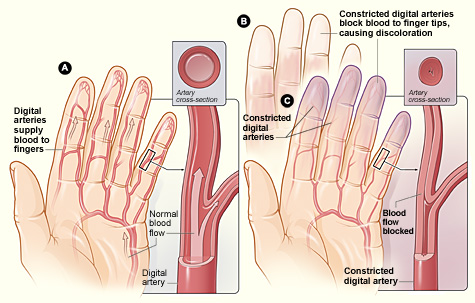I’m sure you’ve noticed that winter is fast approaching, the air is getting colder and the temperatures are dropping! Does the cold weather ever cause your fingers or toes to become blue and numb? If so, Raynaud’s phenomenon may be the reason why!
What is Raynaud’s phenomenon?
Raynaud’s phenomenon, also known as Raynaud’s disease occurs when blood cells in your finger tips or toes overreact to the cold, causing your fingers to turn white, blue, and finally red. This disease is typically diagnosed between the ages of 15 and 30; however it is quite rare, affecting less than 10% of individuals in the United States. Furthermore, females and individuals who live in colder regions are more likely to be afflicted by this disease.

Image: Tcal at English Wikipedia
Types of Raynaud’s Disease
Raynaud’s disease can be classified as either primary or secondary. Anyone can develop primary Raynaud’s; however, chances are heightened for those with a family history. On the contrary, secondary Raynaud’s is uncommon. In fact, only individuals with an underlying medical condition that makes them more prone to the disease (e.g. nerve damage) are at risk for developing secondary Raynaud’s.
0:30-2:30 A more detailed explanation of the major differences between primary and secondary Raynaud’s disease
Video: Johns Hopkins Rheumatology
Symptoms and Causes
The most common symptoms include: numbness, tingling, and sometimes even pain in the fingers and toes. In most cases, symptoms will subside after about 15 minutes when your body warms up and blood flow returns to its normal rate. Additionally, Raynaud’s is triggered primarily by the cold, but other potential triggers include: emotional stress, smoking, caffeine, and certain medications.
How does this happen?
When temperatures drop, your body conserves heat by reducing the rate of blood flow to your hands and feet (i.e. the network of arteries that carry blood to these parts of your body narrow). If you have Raynaud’s disease, however, these arteries narrow more than necessary, causing your fingers and toes to feel numb and turn blue.

An image showing regular blood flow to the fingers (A) versus constricted blood flow to the fingers (B & C)
Image: National Heart,Lung, and Blood Institute: Heart & Vascular Diseases: Raynaud’s: What Is Raynaud’s?
How dangerous is this disease?
Raynaud’s is not dangerous; however, individuals with this condition are more prone to frost bites and spasms in the fingers and toes. Furthermore, in extreme cases, blood flow to the fingers and toes may be completely blocked resulting in potential deformities and tissue damage.
Is there a cure?
There are no known cures for Raynaud’s; however, symptoms typically improve over time. Simple measures, such as covering exposed skin can be taken to prevent any symptoms. However, if you do happen to experience any symptoms, soaking the area in warm water can help relieve them.
Sami Ko
